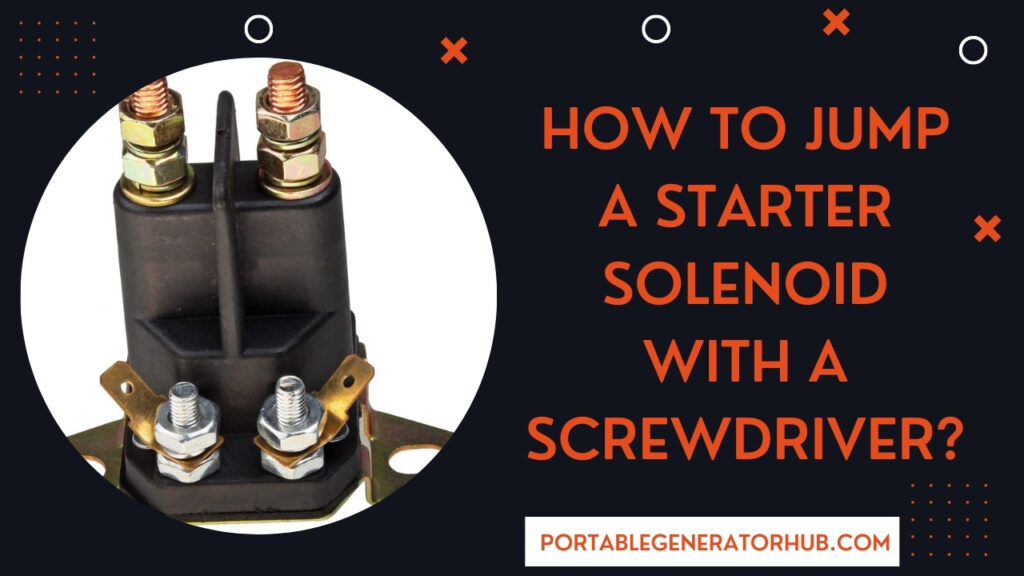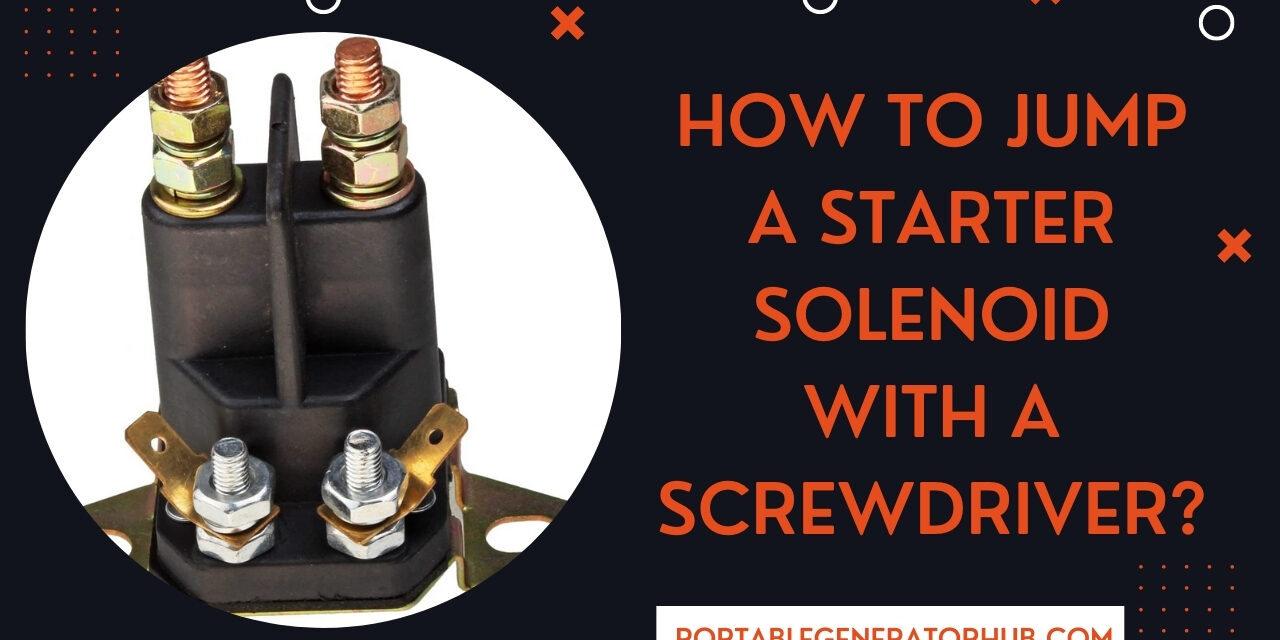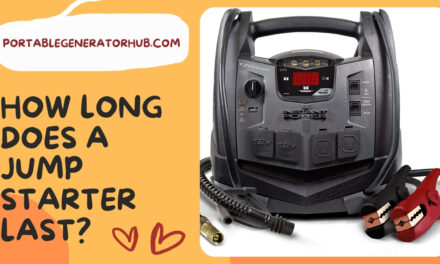
Are you finding it difficult to ignite your car engine? If that’s the issue at hand, then you might need to check the battery appropriately. A dead battery won’t work for your car.
Howbeit, you can use your voltmeter to check if there is a voltage drop. Provided the battery is in good condition, then it might be the starter solenoid.
Starter solenoid works alongside the car battery and the electric starter. Starter solenoid stabilizes low current and high current with the aid of its electromagnetic force on its inside.
The battery produces the surge through the voltage threshold after turning on the ignition with your car key. The spark is then transmitted to the starter solenoid for enhancement before conveying the output to the electric motor.
Invariably, the three starting components have intertwined/relative functions. The battery, starter solenoid, and electric motor all work together to power the engine.
Even right from your observation, you’ll see that the three are interconnected. The battery’s red cord moves from the positive terminal to the solenoid.
So, learn How to Jump a Starter Solenoid with a Screwdriver if you find resounding clicks emerging but unable to turn on the car engine.
You’ll need this article to understand the features of a starter solenoid and what to expect when using your screwdriver on it.
How To Jump A Starter Solenoid With A Screwdriver: 7 Steps To Follow
1. Deciphering The Defaults By Listening To The Sounds Emerging
When the car abruptly stops while you’re driving, it could be fuel or whatever. However, when you ignite the car but no sound sprouts afterward, you might need to check the battery. You can also check the relay starter (this is difficult to solve) if possible.
Provided it makes a screeching sound each time you turn on the ignition with your car key but swiftly stops, then the starter solenoid is faulty. But in a case it makes a choppy sound that lasts for seconds but doesn’t pick eventually, then the starter motor needs attention.
Having made these evaluations and you conclude that the default is from the starter solenoid, you can practically carry out the following directions to solve the issue.
2. Identifying The Starter Solenoid
Open the car bonnet to see the entire components that make up the internal components aside from the chassis. Every car has its peculiarities, so you need to use the manual to do that absolutely well.
Single-handedly find the car battery and identify the terminals on it. Use the connector that bears the red wire to grasp the positive cord. Trace the positive cable to the end terminal.
The next end’s positive terminal belongs to the starter solenoid – the starter solenoid clamps on the electric motor that ignites the engine. Meanwhile, you’d find a single connector right in the middle of the two terminals. Of course, you don’t have a business with that, at least for now. Once you’ve identified the starter solenoid, you can proceed to the next point.
3. Preparation
- You’d need a screwdriver available before you start the operation.
- Before you touch the starter solenoid, you must have checked the battery on your car to see if it’s completely safe. It’s afterward that you can check the electric motor also.
- Getting a partner before starting is an excellent idea. In the course of jumpstarting the car, you’ll need another person to start the car from inside.
- Even if you use a screwdriver, make sure you get hand gloves to be sure you’re well protected.
- Support the bonnet as you suspend it upward so that you won’t get your head smacked by it when working.
4. Step 1: Checking The Wire Connections
The whole ignition process works because each time you turn on the key right on your car, your battery generates a 12V spark, which is obviously not enough to get your car powered.
However, the spark travels straight to the starter solenoid through the positive cord. The starter solenoid has its interior channeled to provide an electromagnetic field. The resultant maximizes the voltage and transmits it through the outward space straight to the pinion gear.
In fact, the starter solenoid features a membrane and a plunger on its inside. It also features coils, walls, and other components that generate electromagnetic force. These compartments will maximize the resultant voltage escaping to the electric motor.
Besides, since starter solenoids are in DC voltages, the output propels the pinion gear and the ring gear in the engine bay in order to ignite the engine.
So, check if the wires are well connected to their respective terminals before you start your operation. If they are not, you can use the spanner you’ve got to attach the connectors to their respective terminals.
The wire from the battery’s positive terminal runs straight to the positive terminal of the solenoid while the negative cord goes to the negative terminal of the electric motor.
The wire from the negative terminal of the starter solenoid runs attached to the designed part of the electric starter. In addition, the wire that runs from the middle of the two terminals of the solenoid is for the starter relay’s negative side connector. The wire at the positive end goes to the ignition switch of the car.
5. Step 2: Appropriately Using the Screwdriver
- Ensure that your hand gloves are on before you start this one.
- Hold the insulated part of the screwdriver as you locate the negative/outlet connector that connects to the electric motor.
- Use the tip of the screwdriver to adjust the outlet connector of the starter solenoid to the relative recipient on the electric motor.
- Ask your partner to turn on the ignition as you bypass the negative probe and the connector’s receptor on the starter solenoid with the tip of your screwdriver.
- Remember that spark transmits from the battery all through various mediums to the starter solenoid; so, make sure that water is not dripping while you’re doing that.
6. Step 3: Relays To Watch Out For
Ask your partner to hop inside the car and ignite the car. Your partner should do this after you’ve firmly adjusted the connector to the electric motor.
If it doesn’t make any sound, but the battery is in fine condition, then you might need to check the relay starters. You can trace the cord that runs from the center of the starter solenoid to the relay starter to see if it was well fixed. The fuse may be burnt or so. You’ll even see the indication that your relay starter is working from the inside of the car.
Once you’ve done that and nothing positive is yielding; then you probably have to check out the next point.
7. Safety Precautions
You don’t have to start exhuming the entire components to get the connector of one end fixed to its respective spot on the other end. You can also call the attention of a mechanic to get the repair done to save time.
Also, you’d need to adequately pull over before doing this so that the vehicle won’t jerk while you’re doing it.
Furthermore, a voltmeter will aid you in identifying the condition of your battery status. Connect the wires from the voltmeter to the correlated wires relatively and check the screen to see if it reads 12V.
If it reads less, then you might need to remove the rust on the battery terminals before trying again or recharge your battery. Nonetheless, you’d still need to put on your waterproof hand gloves while doing these.
How Do You Bypass A Starter Solenoid With A Screwdriver?
This is as simple as jumpstarting the car by intercepting the generator wire’s connector and the electric motor’s recipient connector with the tip of a screwdriver to crank the engine.
It’s an act that would condense the freezes on the inside of the electric motor. Simultaneously cracking the engine while the interception is done intermittently will help vehicle owners to de-freeze the electric motor.
Concurrently doing that would definitely ignite your car successfully. All you just need is to ensure that the starter solenoid has defaulted already so that you can attain a positive end.
What Are The Signs Of A Bad Starter Solenoid?
Several occurrences could indicate your solenoid is not working. One of them is the non-compliance of the engine to pick after turning on the switch. Remember that the apt efficient voltage that the starter solenoid magnifies propels the engine’s pinion gear and ring gear.
Therefore, the inability of the pinion gear to turn could mean the starter solenoid is somewhat bad – it might have lost its function and need replacement. Concurrently hearing screeching sounds could likewise mean the solenoid is bad and may need manual adjustment by bypassing the connectors with the tip of a screwdriver.
Also, although the car is making choppy sounds, touching the solenoid and seeing that it’s quite hot could help you ascertain the starter solenoid is spoilt.
How Do You Test A S0tarter Solenoid?
Multimeter is the ultimate accessory for testing the condition of a starter solenoid. Notwithstanding, you can use a voltmeter also. What you need is the proper presetting of the two so that you can know whether the starter solenoid is working or not.
Grab the probe of the positive terminal of the multimeter and put it on the corresponding positive terminal of the solenoid where the red connector is. Attach the other probe to the second terminal while you check the resistance.
It should read nothing less than 5 ohms once your partner ignites the car from the inside. You can as well preset the multimeter to 20V DC to check if there was a voltage drop. If it reads more than 0.2V, then it means the solenoid is faulty. You can use a voltmeter the same way we’ve just illustrated that for a multimeter.
How Do You Diagnose A Bad Solenoid?
You can take the car to a nearby mechanic for diagnosis. Notwithstanding, you can use a multimeter and voltmeter to evaluate the condition of the solenoid. Even after verifying that it’s bad, you’d still need aid from a practitioner to finally conclude and find a great replacement for you.
Can A Solenoid Click And Still Be Bad?
No, it can’t be. It’s only when there is no clicking that you can suppose the solenoid has gone spoilt. When there is clicking, it means the surge is penetrating the solenoid.
But the electromagnetic force is yet to magnify and stabilize the voltage to the electric motor. Of course, if that’s not rectified by bypassing the starter solenoid with a screwdriver, there is a possibility the clicking would continue on and on.
Final Thoughts
That’s how to Jump a starter solenoid with a screwdriver. Use the screwdriver with the metal head to demarcate between the receptive metal of the electric motor and the connector from the negative terminal of the starter solenoid as your partner switches on the ignition intermittently.
The recursion of the starting system should be done until the clicks turn to a complete start of the vehicle. Nonetheless, just as we’ve advised earlier, get a mechanic to repair the car if all situations become complicated and intense.





